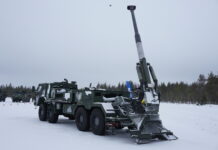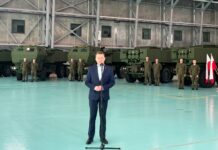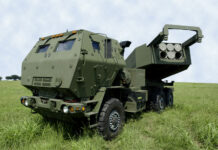About 19 months have passed since the Russian invasion of Ukraine. What was supposed to be a rapid campaign taking just a few days, has morphed into a grinding attritional battle, with both sides continuing to suffer significant personnel and materiel losses. In the midst of this dreadful conflict, it has become clear that artillery has returned to claim a major, some might say pre-eminent, role on the modern battlefield.
In the context of artillery, the conflict in Ukraine is the most significant utilisation of both tube and rocket artillery in the modern era. As such, it will clearly influence artillery system acquisition and the development of operational doctrine in Europe and beyond.

Soviet Legacy
When Russian troops invaded Ukraine, both sides had an artillery park that was primarily based on Soviet-era systems, munitions and, in many cases, employment doctrine. In the Imperial Russian Army and then the successor Soviet Army, considerable prestige was attached to service in the artillery branch. The Soviet military was also wedded to analysing its combat experiences, and this was particularly true of the ‘Great Patriotic War’ of 1941-1945. All aspects of the conflict were analysed in depth in the Soviet General Staff studies of all of the major combat operations. Moreover, many of these operations took place in areas where the current conflict between Russia and Ukraine is being fought.
The studies prepared by the Soviet General Staff are still incredibly relevant, for example the use of defensive works by the Soviet Army at Kursk in 1943, finds an echo in the defensive belts and minefields constructed by the Russian Army to defend its position in Ukraine. The objectives are the same, offensive actions by the opponent are absorbed by the defensive belts, these weaken the opponent via attrition and remove offensive impetus, opening the way to a counterattack or creating an operational stalemate.
The importance of ‘Great Patriotic War’ combat operations on Soviet and post-Soviet artillery developments cannot be underestimated. Between 1941 and 1944, Soviet estimates were that artillery caused 51% of their combat casualties. In 1945, that figure had risen to 61%! As a comparison, in the Korean War (1950-1953) it is estimated that some 60% of US troops killed in action resulted from blast or fragments from artillery and mortars.
Another important point to bear in mind is that Soviet artillery was based on both tube artillery and multiple rocket launcher (MRL) systems. Indeed, the Soviet Army was the first to introduce MRL systems to combat, on 14 July 1941, near the Orsha railway junction in what is now Belarus. The combat power of Soviet artillery grew substantially during the conflict on the Eastern Front and by the end of hostilities it was determined that some 70% of opposition personnel and materiel losses were caused by artillery. The critical lesson learned during the conflict on the Eastern Front was that the suppression and destruction of enemy artillery was the prerequisite to success on the battlefield in both offensive and defensive operations.
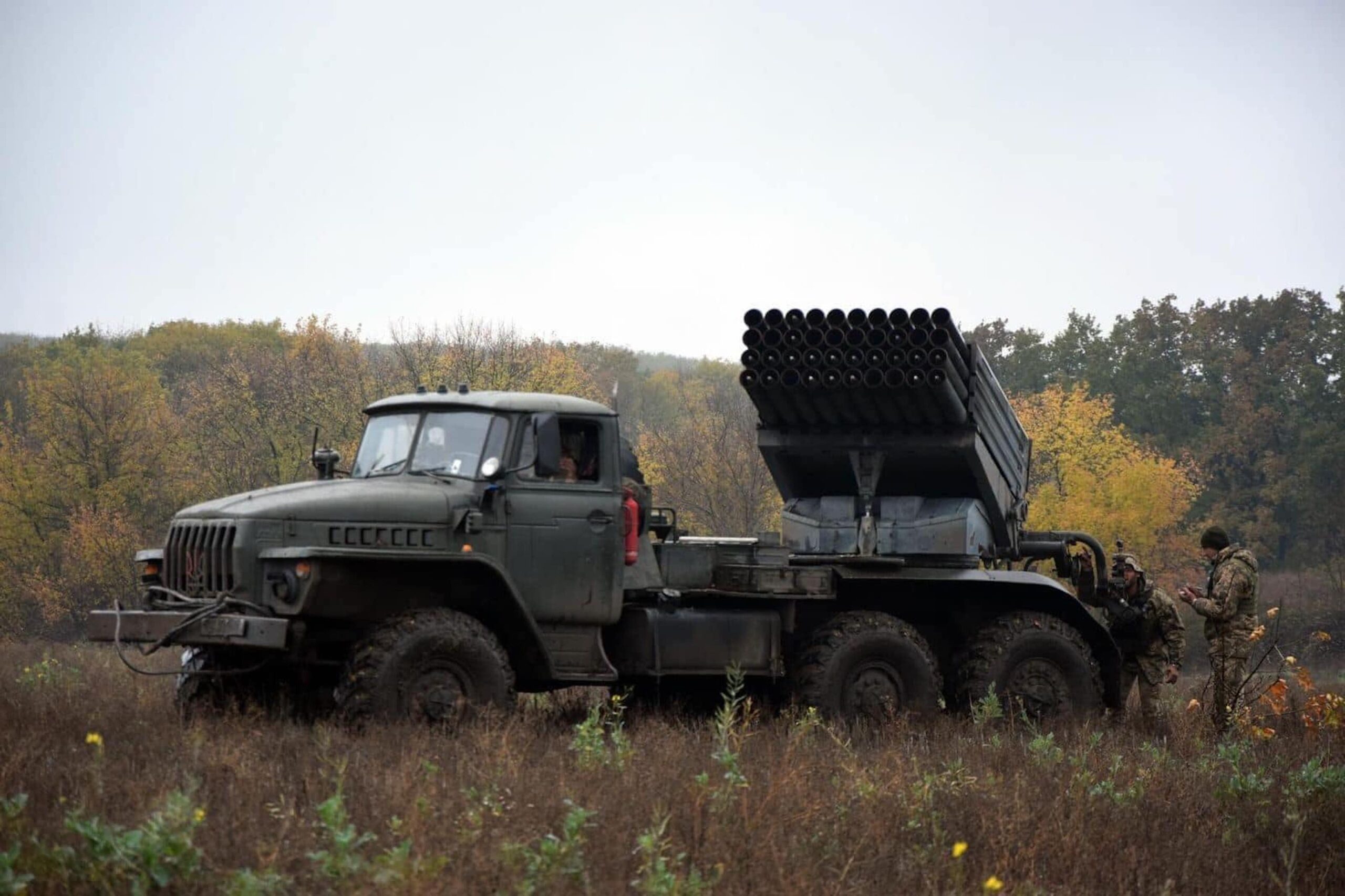
Artillery evolved beyond a simple choice between tubes and MRL systems, as rocketry in the form of tactical ballistic missiles (TBM) entered the equation. Soviet artillery deployed the 2K6 Luna, with two configurations known as Frog 3 and Frog 5 to NATO. The missile had a maximum range of 45 km and could accommodate either a nuclear or HE warhead. Then came the far more successful 9K52 Luna-M (Frog 7) with a range of 65 km and choice of nuclear warheads with selectable yields from 3 kT up to 200 kT. In addition, there was an HE-FRAG warhead, a chemical warhead with a VX nerve agent payload and a warhead with sub-munitions.
The successor to the Frog was the OTR-21 Tochka/Tochka-U, the Tochka arrived in the mid-1970s, with the Tochka-U fielded at the end of the 1980s. Warheads were HE-F, sub-munition, EMP and nuclear, with yield scalable from 10 kT to 100 kT. Range for the initial Tochka was 70 km and the Tochka-U could reach 120 km.
Tochka systems have been utilised by both Russia and Ukraine in the current conflict. Equivalent Western systems included the Lance, in service from the early 1970s to the early 1990s, with a range of 121 km and a selection of nuclear warheads, including a neutron warhead, plus sub-munition and HE warhead options. France had its own system in the form of the Pluton, in service from the mid-1970s to the early 1990s. This had 15 kT or 25 kT nuclear warheads, plus an HE warhead option and a range of around 120 km.
All of these systems with ranges out to 120 km could be classified as battlefield or pre-strategic systems. Ballistic missiles, such as the R-11 and R-17 Scud with maximum ranges beyond 300 km (Scud B) out to 700 km (Scud D) and the 9M723 missile for the Iskander-M system was introduced by Russia in 2006 with a range out to 500 km, are dual-capable systems. These are dual-capable systems, capable of being outfitted with nuclear or conventional warheads. While numerous states retain both nuclear and chemical rounds for their artillery, thankfully, major conflicts involving Weapons of Mass Destruction (WMD) have not broken out in recent years.
The Current Environment
As military art moved beyond the use of WMD, the primacy of artillery as the central source of firepower for ground forces was increasingly challenged by airpower. Aircraft in ground-attack missions were joined by attack helicopters, for the US and other NATO nations it was control of the air that was seen as a truly decisive element in ensuring successful outcomes in ground combat. It is impossible to underestimate the importance of air superiority over the battlefield, but the assumption that air superiority will always be achievable is where problems start to arise. In the ongoing Russo-Ukrainian conflict, neither side has been able to achieve air superiority, meaning the role of artillery has returned to pre-eminence.
As shown in the accompanying tables (see Tables 1, 2 & 3), both Russia and Ukraine were equipped with virtually the same artillery systems at the start of the conflict in terms of towed, self-propelled and MRL systems. Both sides were therefore fully cognizant of the performance parameters of the opposition’s artillery. Not to forget the practical artillery experience gained by both sides during combat operations in the Donbas from 2014 onwards.
Bearing these facts in mind, plus the fact that Russia had a significant numerical advantage in artillery systems, the fact that they were unable to dominate the battlefield with their artillery is a major failure. That being said, in the initial period of the current conflict, Russian planning was based on a victory in days with the rapid collapse of Ukrainian resistance. In those circumstances it would not have been necessary to utilise the plethora of artillery systems available to Russian forces.
Table 1: Soviet Calibre Towed Artillery in Russian & Ukrainian Service
| Calibre | Designator | Russia | Ukraine |
| 100 mm gun | MT-12 | Yes | Yes |
| 120 mm gun/mortar | 2B16 Nona-K | Yes | Yes |
| 122 mm howitzer | D-30 | Yes | Yes |
| 130 mm gun | M-46 | No | Yes |
| 152 mm gun/howitzer | D-20 | Yes | Yes |
| 152 mm howitzer | 2A65 Msta-B | Yes | Yes |
| 152 mm howitzer | 2A36 Giatsint-B | Yes | Yes |
Table 2: Soviet Calibre Self-Propelled Artillery in Russian & Ukrainian Service
| Calibre | Designator | Russia | Ukraine |
| 120 mm gun/mortar | 2S23 Nona-SVK | Yes | No |
| 120 mm gun/mortar | 2S9 Nona | Yes | Yes |
| 120 mm mortar | 2S34 Khosta | Yes | No |
| 120 mm mortar | BARS-8MMK | No | Yes |
| 120 mm mortar | BTR-3M2 | No | Yes |
| 122 mm howitzer | 2S1 Gvozdika | Yes | Yes |
| 152 mm howitzer | 2S3 Akatsiya | Yes | Yes |
| 152 mm howitzer | 2S5 Giatsint-S | Yes | Yes |
| 152 mm howitzer | 2S19 Msta-S | Yes | Yes |
| 152 mm howitzer | 2S33 Msta-SM2 | Yes | Yes |
| 203 mm howitzer | 2S7 Pion | No | Yes |
| 203 mm howitzer | 2S7M Malka | Yes | No |
| 240 mm mortar | 2S4 Tyulpan | Yes | No |
Table 3: Soviet Calibre Multiple Rocket Launchers in Russian & Ukrainian Service
| Calibre | Designator | Russia | Ukraine |
| 122 mm | BM-21 Grad | Yes | Yes |
| 122 mm | 2B26 Grad-K | Yes | No |
| 122 mm | Bastion-1 | No | Yes |
| 122 mm | 2B17M Tornado-G | Yes | No |
| 220 mm | BM-27 Uragan | Yes | Yes |
| 220 mm | TOS-1A | Yes | No |
| 220 mm | Bureviy | No | Yes |
| 300 mm | BM-30 Smerch | Yes | Yes |
| 300 mm | 9K515 Tornado-S | Yes | No |
For all of the new thinking on artillery, there are also old lessons that are still proving their relevance today. The first of these is ammunition and its usage, which has far outstripped expected norms. Admittedly, both sides are firing a prodigious number of rounds, but from the perspective of NATO forces, it was always known that far too many nations lacked adequate ammunition stockpiles for any form of sustained combat operations. Years of asymmetric conflicts hardly created an environment for budgets to be sympathetic towards artillery systems and ammunition.
Another old lesson that has shown its importance time and again is that it is vital to suppress hostile artillery if any real offensive or defensive progress is to be made. This led to the counter-battery mission taking on critical importance and to countermeasures being employed. Typically, artillery systems would be dispersed and would go rapidly into and out of action before moving to a new location, hopefully before they could be engaged. One significant development in the current conflict has been the targeting of artillery systems and their associated command and support elements by UAVs, which adds further complexity to the effective management and utilisation of artillery assets.
There are many lessons to be learned from Ukraine; arguably the most significant is an old lesson – the importance of effective artillery on the battlefield. As previously noted, at the start of the current conflict, both Russia and Ukraine used essentially the same artillery systems. Ukraine would then receive international assistance (see Tables 4, 5 & 6) in terms of the supply of towed, self-propelled and MRL artillery systems.
Table 4: NATO calibre Towed Howitzers Supplied to Ukraine post-February 2022
| Calibre | Designator | Source |
| 105 mm | L118/L119/M119 Light Gun | UK + US |
| 105 mm | M101 | Lithuania + Others |
| 105 mm | Model 56 | Spain |
| 155 mm | FH-70 | Estonia + Italy |
| 155 mm | TRF1 | France |
| 155 mm | M777 | US, Australia + Canada |
Table 5: NATO sourced/Indigenous Self-Propelled Howitzers Supplied/To Be Supplied to Ukraine
| Calibre | Designator | Source |
| 152 mm L37 | ShKH vz.77 Dana | Czech Republic |
| 152 mm L37 | Dana M2 | Czech Republic |
| 155 mm L39 | M109A3GN | Norway |
| 155 mm L39 | M109L | Italy |
| 155 mm L39 | M109A4BE | via UK |
| 155 mm L39 | M109A6 | US |
| 155 mm L39 | M109A5Ö | Latvia |
| 155 mm L39 | AS90 | UK |
| 155 mm L52 | Zuzana 2 | Slovakia |
| 155 mm L52 | Caesar | France, Denmark |
| 155 mm L52 | PzH 2000 | Germany, Netherlands, Italy |
| 155 mm L52 | AHS Krab | Poland |
| 155 mm L52 | T-155 Firtina | Turkey |
| 155 mm L52 | RCH 155 | Germany |
| 155 mm L52 | Archer | Sweden |
| 155 mm L52 | 2S22 Bohdana | Ukraine |
Table 6: NATO-sourced Multiple-Rocket Systems Supplied/To Be Supplied to the Ukraine
| Calibre | Designator | Source |
| 122 mm | RM-70 | Czech Republic |
| 122 mm | RM-70 Vampire | Czech Republic |
| 122 mm | BM-21 | Czech Republic (ex-Bulgaria) |
| 122 mm | BM-21 | Poland |
| 122 mm | APR-40 (BM-21) | Romania |
| 128 mm | RAK SA-12 | Croatia |
| 227 mm | M270B1 MLRS | UK |
| 227 mm | M270 MARS MLRS | Germany |
| 227 mm | M270A1 LRU MLRS | France |
| 227 mm | M270A1 MLRS-I | Italy |
| 227 mm | M142 HIMARS | US |
| 230 mm | TRLG-230 | Turkey |
The arrival of these foreign artillery systems was obviously welcomed by the Ukrainian Ground Forces (UGF). However, finding crews for all of these new systems, training on how to use them, and then understanding their operational characteristics for full effect, has represented a massive challenge. Beyond that was the logistics and support challenge for these new systems, and all of sudden you are dealing with new ammunition types in unfamiliar calibres and a host of other problematic areas.
Learning lessons
There is extensive OSINT information regarding artillery in the Russo-Ukraine conflict; whilst it might not be 100% reliable, it does enable key trends to be identified. One of the most significant is the vulnerability of towed artillery systems – here loss rates have become alarming.
Major towed artillery system losses for Russia included 76 D-30 122 mm howitzers, 109 2A65 Msta-B 152 mm howitzers and 39 2A36 Giatsint-B 152 mm field guns. For Ukraine, losses of equivalent systems included nine D-30, six 2A65 Msta-B and 14 2A36 Giatsint-B units. Turning to foreign equipment supplied to Ukraine, a total of 67 M777 howitzers have been lost, captured or damaged, equating to a third of the number of these systems supplied. Readers should also note that Ukrainian losses tend to be under-reported in many Western sources, and the real loss figures are likely far higher.
It would appear that towed artillery has become incredibly vulnerable in an environment where rapid counter-battery action is a key mission. It takes too long to get into and out of action and then redeploy. Another issue is that many of these towed guns are out-ranged by opposing force artillery systems. In a manoeuvre battle, the limitations of towed artillery are readily apparent, but in a defensive battle where the frontline is static and towed systems can be dug in and better protected, they still have a role to play. If towed systems are to be used, camouflage and concealment are priorities.
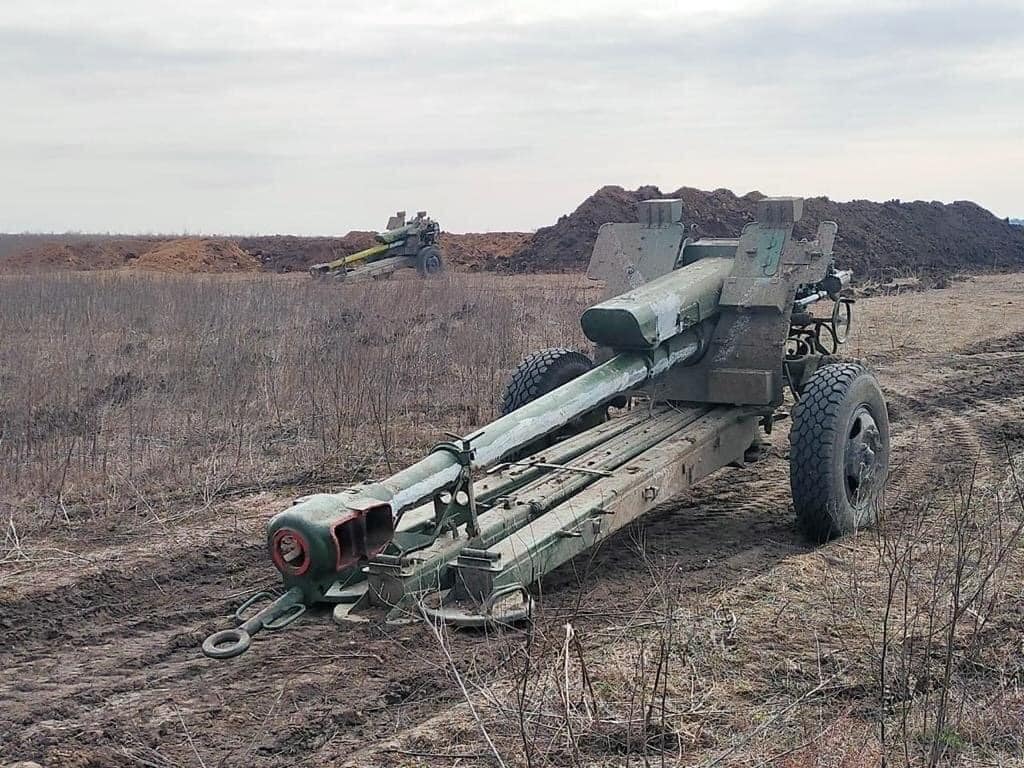
Bearing in mind the limitations of towed artillery, self-propelled artillery emerges as the logical solution to artillery requirements. However, they have also proven to be vulnerable in the current conflict. For example, looking at Soviet-era systems operated by both sides. Russia has lost 82 units of the 2S1 Gvozdika and 132 2S3 Akatsiya howitzers, while Ukraine has lost 75 Gvozdika and 34 Akatsiya systems.
Other Russian self-propelled artillery losses have also been severe, and include 42 2S5 Giatsint-S, 143 2S19 Msta-S and 34 2S33 Msta-SM2 howitzers. Ukraine has employed captured Msta-S systems and has also lost some of these in combat. As for Ukraine, they have lost 34 M109s, 21 AHS Krabs, four CAESARs, three Giatsint-S, three AS90s, and small or single quantities of other models. A number of factors influence these loss rates, primarily how and where artillery is employed. Performance in this regard inevitably improves with combat experience. Also important is system performance, with range a critical determinant. The greater the range envelope of a particular system, the greater the deployment possibilities to maximise performance and minimise risk.
The last category of artillery losses to be evaluated is in the category of MRL systems. Once more, Russian losses are severe. They are said to have lost as many as 163 BM-21 Grad 122 mm MRL and smaller quantities of other Grad variants, plus 17 of the modern 2B17 Tornado-G system. Also lost are 67 BM-27 Uragan 220 mm systems and two BM-30 Smerch 300 mm system. Ukrainian MRL losses are reported to include 38 BM-21 systems and three RM-70 systems with a similar performance envelope, six BM-27 Uragan and a single Bureviy.
It is noteworthy that according to the open source figures Ukraine has not lost any of its M270 MLRS or M142 HIMARS systems. These high-value systems are not being risked in the same way that lower-performance MRL systems are. Using GMLRS rockets such as the M30/M31, ranges of out to 84 km can be achieved. More recently, M30A1 rockets have been supplies, and these use a high explosive fragmentation warhead with a large quantity of tungsten fragments, which are suitable to engaging lightly armoured area targets in the open.

One frustration for Ukraine is the limitations that they face in terms of the equipment that they can acquire. In the context of MLRS/HIMARS, they would really like to add ATACMS to their rocket arsenal. ATACMS would enable them to accurately engage targets out to 300 km, offering obvious operational advantages. Presumably the US is withholding ATACMS to avoid escalation, something that would be difficult to explain to the Ukrainians as their cities and civilian populations are targeted. In future, ATACMS will be replaced in US service by the Precision Strike Missile (PrSM), which has a range of 499 km, with the possibility of further extending this range in future modifications.
Looking Ahead
The conflict in Ukraine has provided real lessons on the employment of artillery in a conventional conflict under modern conditions. The knowledge gained from the war in Ukraine ought to change how other ground forces think about artillery in terms of acceptable performance, deployment, command and control (C2) and provision of ammunition and support.
First and foremost, this conflict has transformed the artillery ammunition production picture in Europe. All of a sudden, serious 155 mm ammunition orders are being placed and in the case of Ukraine, significant 122 mm ammunition production has commenced. With artillery ammunition being fired at rates that were typical of intense combat in World War II, levels of ammunition that were once thought adequate have been exposed as totally inadequate.
Regarding tube artillery systems, the key performance factors would be mobility, into and out of action time, the dispersal of fire units, and the ability to accurately engage targets at extended ranges. Friendly artillery would ideally out-range hostile artillery, thus maximising deployment possibilities and dominating the artillery battle. There are now doubts over the long-term viability of towed artillery, which in turn leads to concerns over artillery support for air mobile operations, with new thinking and new artillery systems required to support airmobile operations. Successor systems to the 105 mm Light Gun and the M777 will likely have to operate in far more challenging environments.
This indicates that self-propelled tube artillery is the basis for ground forces to build their artillery future. The presence of 155 mm L52 ordnance has transformed the capabilities of tube artillery systems, but as noted, more performance in terms of extended engagement ranges is required. Rheinmetall is working towards increasing the range of current 155 mm L52 systems from 40 km out to 63 km and then to 68 km in the medium term. Beyond that, they are looking at an L60 weapon to attain a range of 82 km.
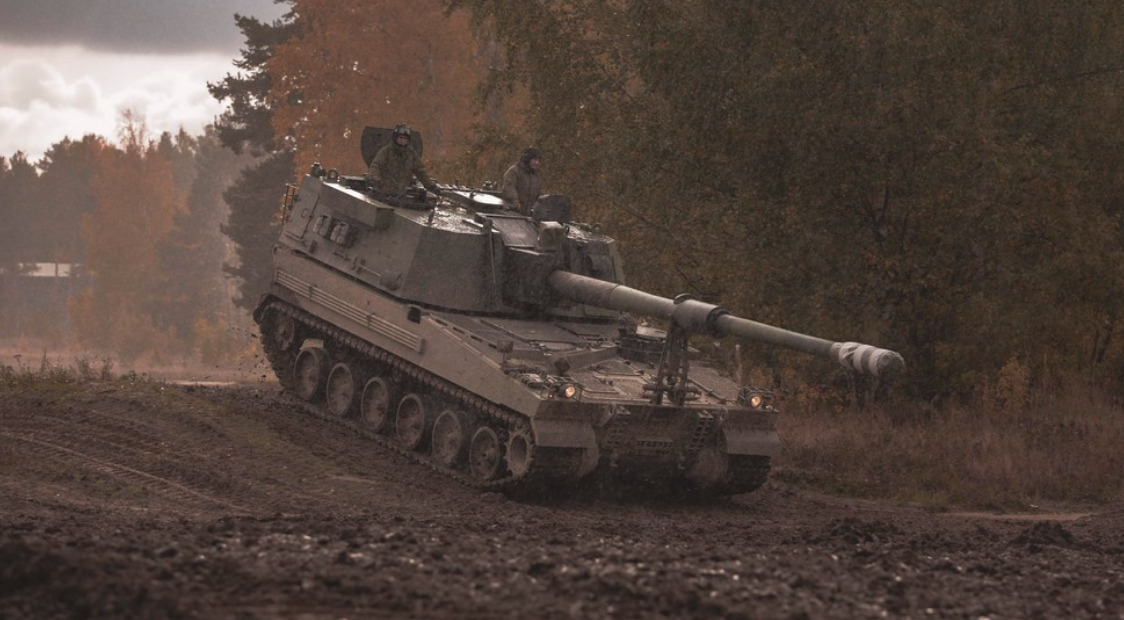
Others are also working on extending artillery system ranges. In the Republic of Korea (ROK), the K9A2 variant of the K9, presently completing development, is being fitted with an autoloader capable of allowing a rate of fire of 10 rounds per minute. Further down the line, the planned K9A3 variant is slated to receive an L58 gun, increasing ranges by approximately 10 km over the existing limits (roughly 50-80 km depending on the ammunition type). After that, a future robotised variant of K9 could be capable of fully autonomous operation.
Fielding artillery with the extended ranges under discussion will be a major development, but future systems will need to have the ability to reliably acquire, designate and engage targets at these extended ranges. Identifying and engaging threats before being engaged is critical. Another important item is that artillery systems must have enhanced protection, and obviously improved mobility, plus camouflage and concealment will help. However, the UAV threat needs to be countered as a matter of urgency, with both soft-kill and hard-kill C-UAV means being required.
The availability of HIMARS and MLRS systems has provided Ukraine with a long-range precision strike capability, as previously noted though, the US has been reluctant to supply extended-range ATACMS missiles that would further increase the reach of these systems. Despite that, the ability to engage high-value targets such as bridges, ammunition dumps and command centres at extended ranges has been immensely valuable.
The operational potential of HIMARS and MLRS, plus the possibilities on offer from extended range rockets, make these systems an important capability. The downside of this is that everybody now recognises what these systems are capable of and opposing forces will therefore look to neutralise such systems as a matter of urgency. Asset protection will therefore become very important when fielding HIMARS and MLRS.

The US Army is developing a new self-propelled artillery system and in parallel, it will field new generation extended-range rockets (ER GMLRS and PrSM) for HIMARS and MLRS. Elsewhere, the British Army is upgrading its MLRS launchers to the M270B1 configuration allowing the use of the Guided ER GMLRS rocket. In parallel, the UK is moving forward with a new 155 mm artillery system in the form of the Mobile Fires Platform (MFP). These are just two examples of the enduring belief that the future of artillery is based on a balanced force consisting of self-propelled tube and rocket systems.
David Saw



